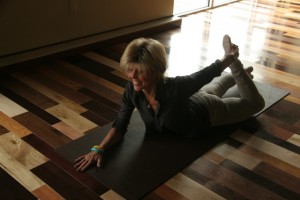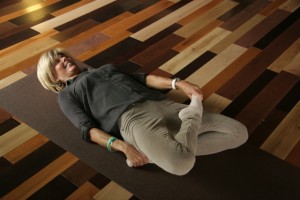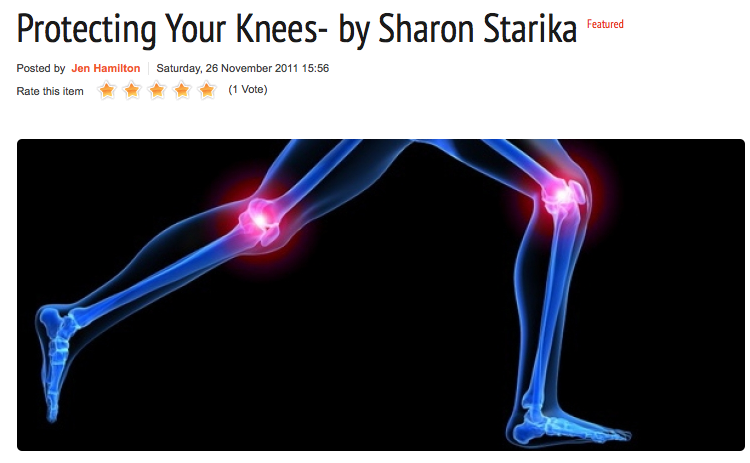Learn how to better protect your knees by reading this article featured on TriEdge.net.
Knee pain is no stranger to athletes of all kinds. Running, in particular, often gets a bad rap for creating knee pain. However, knee pain isn’t created from running, it ‘s more about the biomechanics while running, cycling, hiking, skiing, and even sitting.
What you do in your daily life makes up your biomechanics. So if you have a desk job, most likely you are stiff and tight in your hips and hamstrings from the continuous habit of sitting. After a long day of sitting, it is challenging to immediately open the hips and lengthen the hamstrings. So if you head out for a run right after a day at work, you will most likely lean your upper body slightly forward to compensate. You may not even feel it until reading this article and begin to notice. You may even simply jet your head out slightly which will have the same affect. Such a slight bend forward will allow the hips and hamstrings to remain tight which then pulls on the knees. It is utterly impossible to lengthen your leg behind oneself with tight hips. So the tight hips and hamstrings, keep the knees slightly bent which increases direct pressure through the knees. So is it really the running, or sitting at the desk all day that brings pressure and pain to the knees? The same goes for avid cyclists and skiers. Both of these activities tighten the hips due to the incredible demand on quadriceps and hamstrings. In fact, cycling can be the worst because you never get to fully extend the leg while spinning. Many specialists suggest cycling will help prevent knee problems. I heartily disagree if you don’t properly stretch after a ride or spin class. In fact, sitting on a bike with the hip area closed for long periods of time not only tightens the hips tremendously but tightens the hamstrings, which directly adds pressure to the knee joint.
Over a period of time, without proper stretching, the knees can begin to feel stiff and painful when you have lost the ability to fully extend your leg. I know, how many times have you been told to stretch? Many. So stretch. It is critical to stretch all the muscles deep in the pelvic area to avoid knee pain. In addition, as I mentioned earlier, it is critical to open up the mid-back, thoracic spine area to keep the knees pain free. Think of the entire body. To notice, feel and become aware of how you feel in your upper body as well as your lower body. Are your shoulders rounded? Does your head feel forward? Are you able to extend your leg fully behind yourself?
There are several ways to stretch effectively. One is to go to a stretch class, or a yoga class. Secondly, you can stretch on your own. To do so, you must make the time; go slow, and be consistent. What is most important is to stretch after the activity whether it’s running, skiing, cycling, or just a long day at the office. Here are a few simple “active” stretches you can do at home:
 The first one will help determine how tight your hips are. Lie on your stomach. Begin by bending your right knee so the right foot is directed towards the ceiling. Slide your right hand, palm up, under your right hip joint; this is where you will feel the front of the pelvis and the gap where the femur inserts into the pelvis. Now, press down with the hip, bring pressure onto your hand. Most of us will notice immediately, this area is away from your hand. Some of you may find it very difficult to press the hip down onto the hand. This tells you how tight your hip is. Repeat this movement holding down for 10-15 seconds then releasing. Repeat 5-10 times.
The first one will help determine how tight your hips are. Lie on your stomach. Begin by bending your right knee so the right foot is directed towards the ceiling. Slide your right hand, palm up, under your right hip joint; this is where you will feel the front of the pelvis and the gap where the femur inserts into the pelvis. Now, press down with the hip, bring pressure onto your hand. Most of us will notice immediately, this area is away from your hand. Some of you may find it very difficult to press the hip down onto the hand. This tells you how tight your hip is. Repeat this movement holding down for 10-15 seconds then releasing. Repeat 5-10 times.
 Once this becomes easy, then take your right hand out, and grab your right ankle with your right hand. From here, you will continue the same idea, pressing the hip down, once this is achieved, then you can allow the right knee to lift 1”-2” away from floor. Allow the arm and shoulder to lengthen behind you, so know you are getting length in the arm, in the hip as well as extension in the spine. Repeat this pull and lift 3-5 times. Roll onto your back and notice how free the right leg and hip feels and how loose the lower back feels. Return to stomach and repeat on the left side. In time you will be able to finish by grabbing both heels behind you, press both hips into the floor, lifting both knees, lengthen the arms and arch the entire spine.
Once this becomes easy, then take your right hand out, and grab your right ankle with your right hand. From here, you will continue the same idea, pressing the hip down, once this is achieved, then you can allow the right knee to lift 1”-2” away from floor. Allow the arm and shoulder to lengthen behind you, so know you are getting length in the arm, in the hip as well as extension in the spine. Repeat this pull and lift 3-5 times. Roll onto your back and notice how free the right leg and hip feels and how loose the lower back feels. Return to stomach and repeat on the left side. In time you will be able to finish by grabbing both heels behind you, press both hips into the floor, lifting both knees, lengthen the arms and arch the entire spine.
 Return to bent knees, feet standing, slide right foot behind left knee, grab again right ankle with left hand, pull right ankle/foot up to left buttocks. Begin to roll pelvis to right, so left side lifts up to roll to right, this will allow the right thigh to open up and stretch. Make sure to keep left knee and foot standing, so left knee stays pointed towards ceiling as you roll pelvis to right. Then lengthen right arm up by your head, back of hand on the floor, now continue to pull right foot under gap, and you roll pelvis and self to right coming to lie on right side. Still left knee standing straight up. Here you will feel an incredible diagonal stretch. Roll 4-5 times to the right side. Then return onto your back.
Return to bent knees, feet standing, slide right foot behind left knee, grab again right ankle with left hand, pull right ankle/foot up to left buttocks. Begin to roll pelvis to right, so left side lifts up to roll to right, this will allow the right thigh to open up and stretch. Make sure to keep left knee and foot standing, so left knee stays pointed towards ceiling as you roll pelvis to right. Then lengthen right arm up by your head, back of hand on the floor, now continue to pull right foot under gap, and you roll pelvis and self to right coming to lie on right side. Still left knee standing straight up. Here you will feel an incredible diagonal stretch. Roll 4-5 times to the right side. Then return onto your back.
 From your back, lift left foot to place on right thigh, then open left knee out to left side. Lay on your back opening both knees. This is a huge hip opener. Slowly undo legs and repeat with the left leg/side. Remember while doing this active stretch, you are also opening the upper body and your spine, which can contribute to freeing up your knee pain.
From your back, lift left foot to place on right thigh, then open left knee out to left side. Lay on your back opening both knees. This is a huge hip opener. Slowly undo legs and repeat with the left leg/side. Remember while doing this active stretch, you are also opening the upper body and your spine, which can contribute to freeing up your knee pain.



Recent Articles